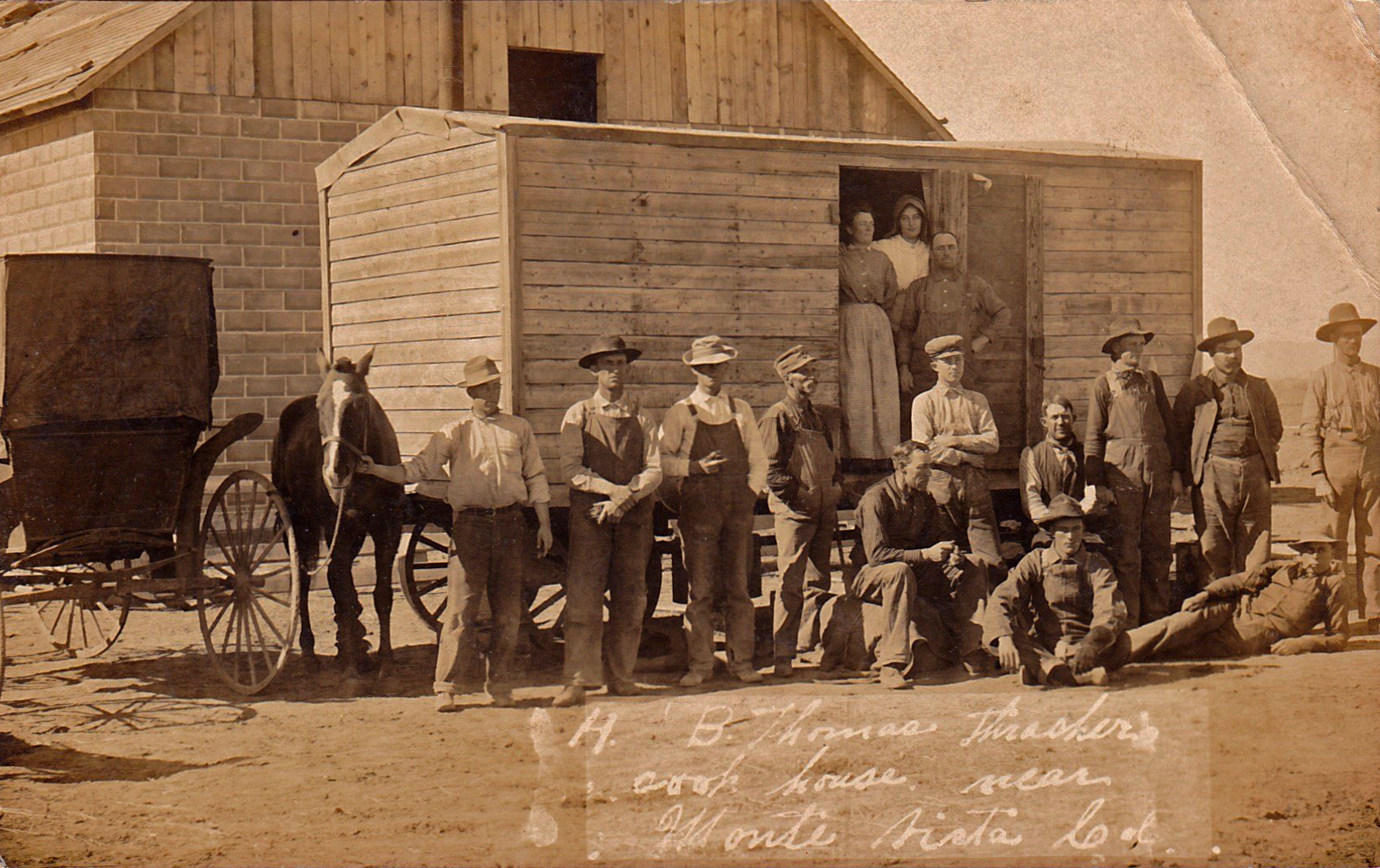The cook house, also called a cook car or cook shack, was critical for providing sustenance to the threshing crews moving from farm to farm during harvest season. In the Monte Vista area, the most threshed corps were probably wheat and barley. Threshing (also called “thrashing” by some, as per the caption at the bottom of the picture) is the process of removing the grain from the stalk. It follows the cutting, or reaping, of the crop.
At the time this photo was taken, a typical threshing “rig” or “outfit” might include a cook house, a steam-powered tractor, the thresher, water and coal wagons to service the tractor and another vehicle to make trips to the nearest store for groceries. Perhaps the buggy at the far left of the photo was used to make those grocery trips. It’s possible one or more people in the picture are members of the family whose crop is being threshed that day. (There’s no indication whether H.B. Thomas, identified as the boss in the photo’s caption, is among those pictured.)
Power for the thresher would have been provided by the tractor. The tractor would have transferred power to the thresher by means of a flywheel on the tractor and a continuous (figure-eight) loop belt connecting it with a pulley on the thresher. The belt would have been made of leather, layers of canvas, or rubber. While powering the thresher, the tractor and the thresher were stationary, for it wouldn’t be practical for both to be moving while connected by belt. The tractor operator would most likely have preferred moving to the next farm as soon as a threshing job was finished, while the steam was still up. He would arrive early the next morning to fire up the engine and get the steam built up.
“Lillie,” the author of this postcard, was most likely one of the two women standing in the door of the cook house, for she writes in her message to Ethel Rice, postmarked in Monte Vista in November of 1909: “Dear Ethel – I know you have looked for a letter for a long time and I will write one, too, some time this week. This picture will give you some idea as to what we are doing, but are going home tomorrow or next day. With love, Lillie”
Cook houses saw their peak use in the late steam-engine era, i.e., from about 1900 to 1920. Their average size was about eight feet in width, sixteen feet in length and seven feet high. They were usually mounted on wagon running gear and thus might require portable steps for access.
The cooking crew probably served five meals a day – i.e., breakfast at the start of the workday, two lunches (served at the midmorning and midafternoon breaks), dinner at mid-day and supper in the evening. For those threshing outfits that had no cook house or cooking crew, the preparation of meals probably fell to family members whose crop was being threshed. Below is a young woman’s account of cooking crew duties which I came across on the website of the Mennonite Heritage and Agricultural Museum in Goessel, Kansas (at https://www.goesselmuseum.com/cook-shack ). While her account doesn’t indicate how many crew members were being fed, it gives a vivid flavor of the amount of daily work involved for a threshing crew cook:
“Breakfast consisted of bacon, eggs, hashbrown potatoes, and a gallon of coffee. For dinner at 11:00 a.m. we cooked a 15 pound roast, 2 types of vegetables, and what seemed to me to be a 1/2 bushel of potatoes. All men liked pie for lunch out in the field. This was another gallon of coffee, sandwiches, and cookies. For supper we had cold meats, potatoes, salads, and cake for dessert”. The museum adds, “These five meals made it necessary to keep the wood-burning stove hot nearly all day. Later, kerosene burning stoves were used.”
(The cook house’s cousin, the chuck wagon, had its origins in Texas. While mobile kitchens had been pulled overland for generations, the chuck wagon is tied specifically to the Texas cattle drives moving herds to the nearest railroad or market, at a time when the railroad had not yet reached Texas. Credit for inventing the chuck wagon goes to Charles Goodnight, a Texas rancher and co-founder, with Oliver Loving, of the Goodnight-Loving trail, which initially ran from Texas up to Fort Sumner in New Mexico and then two years later was extended up through Denver to the Union Pacific town of Cheyenne, Wyoming. Goodnight created the prototype for the chuck wagon in1866 from an army surplus Studebaker-built wagon. The Studebaker company later went on to make automobiles.)
REFERENCES:
- “Antique Power” at https://www.antiquepower.com/…/yujqdh8mp1d1nsfikije0wcq…
- “The Chuck Wagon – The Real Queen of the Cattle Trail,” Legends of American at
https://www.legendsofamerica.com/we-chuckwagon/…. - “Cook Car,” by Amos K. Mast, Farm Collector, dated July/August 1962, at https://www.farmcollector.com/steam-traction/cook-car
- “The Cook Shack,” compiled by Tracy S. Schmidt, , at https://www.goesselmuseum.com/cook-shack
- “Goodnight–Loving Trail,” Wikipedia.org at https://en.wikipedia.org/wiki/Goodnight%E2%80%93Loving_Trail .
- “The Goodnight-Loving Trail,” Legends of America at https://www.legendsofamerica.com/we-goodnight-lovingtrail/
- “Mountain of Facts,” Monte Vista Chamber of Commerce at https://www.montevistachamber.org/mountain-of-facts.html
- “Old Western Wagons – Running Gear for Sale for a Sheepwagon,” by Jim at OldWesternWagons.com, seen on YouTube at https://www.youtube.com/watch?v=EHoRLFiNf-k
- “Steam tractor,” Wikipedia.org at https://en.wikipedia.org/wiki/Steam_tractor
- “Studebaker,” Wikipedia at https://en.wikipedia.org/wiki/Studebaker
- “Threshing,” Wikipedia at https://en.wikipedia.org/wiki/Threshing
- “YOUR HISTORY: Threshing crews now part of farming history,” by Jean M. Stoner, Mount Vernon-Lisbon (Iowa) Sun newspaper, dated August 6, 2008, at http://www.mvlsun.com/article.php?viewID=3268.
- “Cook Car,” by Amos K. Mast, Farm Collector, dated July/August 1962, at https://www.farmcollector.com/steam-traction/cook-car
- “Threshing,” Wikipedia at https://en.wikipedia.org/wiki/Threshing

